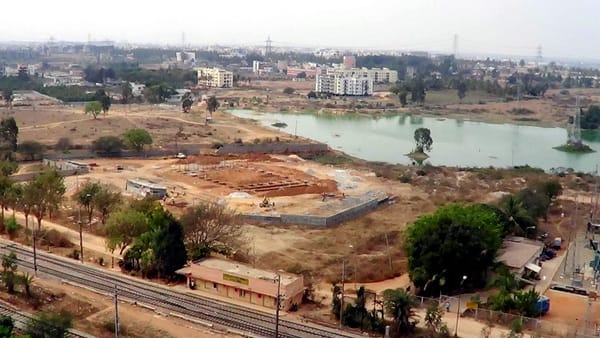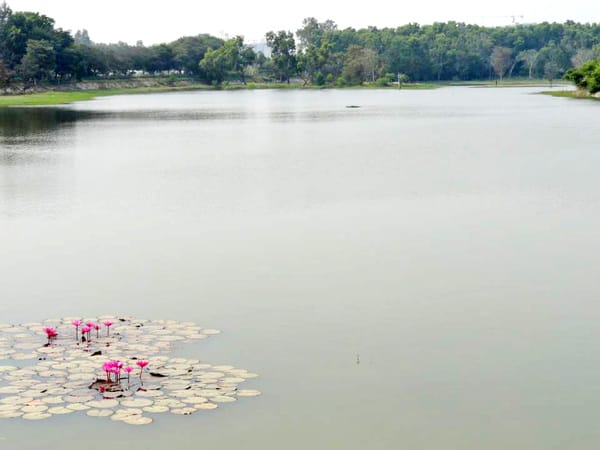One more lake in Bangalore seems to be nearing extinction. Kadugodi lake in Whitefield is the victim. And the encroachers belong to water mafia.
The catchment area of this beautiful lake is being encroached upon by local politicians. They supply water to Whitefield apartments. The water is extracted from the lake and supplied to the apartments at Rs 2,000 per tanker.
As if this is not enough, a new compound and buildings are coming up on the lake bed and catchment area. A few concerned citizens of this area have been trying to bring some limelight on the issue and stop the constructions from coming up, besides saving the lake. Whitefield Rising is one such Facebook group.
One of the volunteers of the group, Veerendra, a resident of Shanitiniketan, spoke to Citizen Matters about the rampant encroachment of the Kadugodi lake. He said that the corporators are establishing community Sewage Treatment plants in the catchment area. This is illegal as per the High Court Committee guidelines given by N K Patil, J.
The water mafia have dug up unauthorised borewells on the lake bed to draw water and make profits. The volunteers went near the lake several times to enquire about the encroachers, but the labourers working there don’t really have any information. A complaint was also made on behalf of Whitefield Rising to the BBMP and the local corporators. But the authorities have not responded. Veerendra has lodged a complaint on ichangemycity.com, a Janagraha initiative.
This is just one case. What is happening in other parts of Bangalore on this front? This reporter tried to explore it.

Construction work continues unabated on Kadugodi lake bed Pic: Whitefield Rising Group
Insights from ‘Save our lakes’
Many people concerned about the protection of lakes congregated at the ‘Save Our Lakes’ programme organised by The Alternative and Korkai in Domlur, on May 10.
Kadugodi lake is not the only one on the list. Pushpa from Lingarajapura, Silver lake champion, who participated in the event, stated that the local corporators encroached the 50-acre Silver lake area to build two temples and a BBMP school.
The encroachers also involve the land mafia. They turn the catchment area of the lake, which is an agricultural land, into a non-agricultural land by planting the eucalyptus trees, explains Peevee, co-founder of Korkai, a photojournalist community initiative. The roots of these trees suck the water and turn the land barren. When this occurs, the mafia sells the land to commercial establishments.
Harini Nagendra, ecologist, stated that the Kaikonderahalli lake was an encroached Kaluve. After the Kaluve was eviscerated of the cattle and the pig farms, the lake was back to its original form. She also stated that the BBMP was quite responsive when approached. Also the pelicans were back once the lake was restored. The lake still faces the challenge of sewage though.
Subramaniam, lake expert, spoke against the private players maintaining the lakes. The guidelines by Justice N.K Patil High Court Committee reject commercial exploitation of any lake under any circumstance. These guidelines give power to remove unauthorized construction within the 30 meters of peripheral lake area. He also spoke of the importance of rainwater harvesting.
Brigesh Mohan, BBMP, claimed that the BBMP is trying to manage 20-25% lakes. He also claimed that 55 lakes are with BBMP and 5 with the Forest Department. The Revenue Departments, BBMP and BDA are said to be under the guidance of the Lok Adalat and High Court. He stated that BBMP is incapable of watching over the lakes and calls on people to become partners in this endeavor.
Lakes – remnants of a glorious past
The beautiful lakes of Bangalore are man-made in nature. They were traditionally built for activities like irrigation, drinking and fishing.
Lord Cornwallis around 1600s had sent an army to Srirangpatnam, which through an alternative route, reached Bangalore. He called it the ‘Land of thousand lakes’.
Some of the lakes have disappeared during the years. The Majestic Bus stand was built over Dharmambudhi lake; Shule lake was converted to Hockey stadium; Sampangi lake made way for Kanteerva stadium; and some of them wiped out under the malaria eradication program. The Ministry of Health and Family Welfare launched this program in 1958 in which it closed down the reservoirs which were infected.
The Arkavati water which generally flows from Nandi hills branches into a Rajakaluve. This further branches out into a lake and chain of lakes. Multiple canals connect the lakes. When WIPRO was established, the inflow to the Madiwala lake was blocked.

Kaikondanahalli lake: A classic example of how a lake can be rejuvenated. Pic courtesy: Saving our lakes FB page
Lake chains, not just lakes
Because of the valleys on which Bangalore is located, the lakes cascade naturally from higher elevation to lower elevation. As the lake on the higher elevation would fill up, water would flow into the lower lakes. Bangalore has three main valley systems: Hebbal, Koramangala – Challaghatta, Vrishabhavati. The lakes thereby form a chain of reservoirs in each of the three valley systems. The existing Rajakaluves are the inlets and outlets of the drainage system for the lakes.
In many places, the sewage pipe and the water pipe are laid out in parallel. The joints of these pipes become weak at certain points and the water tends to mix with sewage. Of the 600 lakes on the revenue records, 189 live lakes are sewage tanks. In such areas, e-coli percolates bore wells and the Cauvery water.
Lakes have to be preserved to maintain the ecological balance. The environmental consequences of the lack of biodiversity and lake systems are not obvious, hence not understandable too. But the city will have to pay a price if we cannot preserve and rejuvenate at least the existing lakes.
National Environment Policy, 2006
Conserving the lakes – checks and balances
The Government of India operationalised a wetland conservation programme in 1985-86 in close collaboration with concerned State Governments. Several steps were allegedly taken to arrest further degradation and shrinkage of water bodies due to encroachment, decline in biodiversity and other associated problems. But this program was restricted to only three lakes in Bangalore.
The Wetland rules 2010, notification brought by the Ministry of Environment and Forests, restricted activities like solid waste dumping and discharge of untreated effluents into lakes; prohibited the construction of a permanent structure except boat jetties for fifty meters of catchment area. Also the State government is to submit prior approval for activities like dredging, withdrawal or impounding of water. It’s presupposed to carry out a detailed Environmental Impact Assessment.
The Lake Development Authority (LDA) is a society under the Societies Registration Act, 1860. Two states, Jammu and Kashmir and Karnataka have established this statutory body, which acts as a principal permitting authority.
Brigesh Mohan said that the BBMP has drafted a policy scrutinised by LDA where the citizens help proactively in the maintenance of the lakes. The citizens can involve themselves during the development stage and later. The members in a ward part of Residents Welfare Associations and financially independent are eligible to be part of this initiative.
If the rules, checks and balances existing on papers can come into practice in reality. Bangaloreans would see more lakes alive and ecosystems thriving.⊕